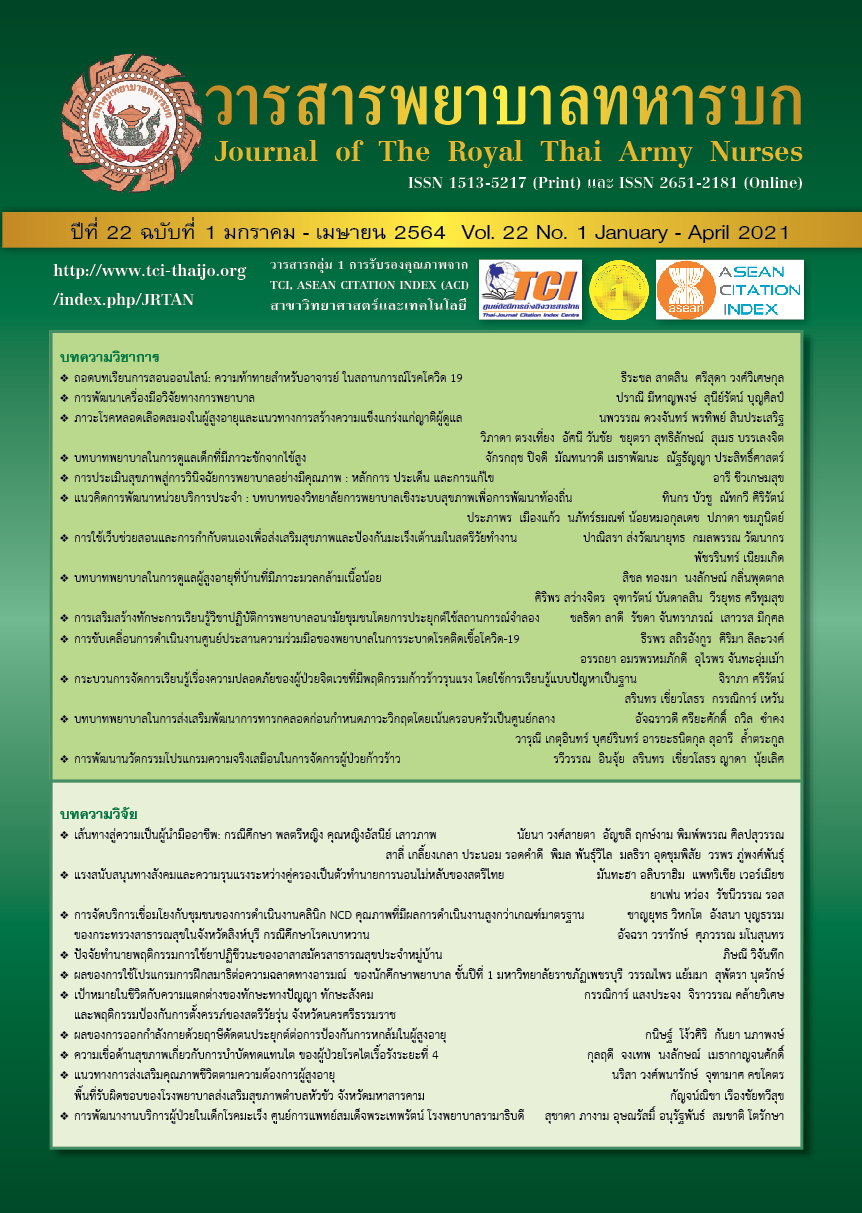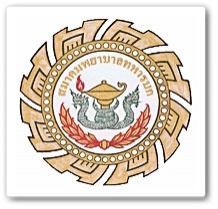The Development of Nursing Research Instruments
Keywords:
Research Instruments, NursingAbstract
The process of developing research instruments in nursing is very important. This is because research tools are used to measure the value of a variable or to collect the data of the variable. It helps to transform abstract concepts into statistical, quantitative or qualitative data. Nursing variables, especially psychological variables, attitudes, behaviors, emotions, and attributes. In social science and management science, researchers cannot measure the variables or need to measure directly differently. Scientific and mathematical measurement. Therefore, nursing researchers must have a good understanding of the research tool development process. To be able to accurately create nursing research tools and get answers to research that meets the objectives of the research. It is important to identify the quality of the research.
Downloads
References
Hinkin TR. A review of scale development practices in the study of organizations. Journal of management. 1995; 21(5): 967 - 88.
DeVellis RF. Scale development: Theory and applications: Sage publications; 2016.
Meehanpong P, Chatdokmaiprai K. Assessing Quality of Research Instrument in Nursing Research. Journal of The Royal Thai Army Nurses. 2018; 19(1): 9-15. (in Thai).
Polit DF, Beck CT. Essentials of nursing research: Appraising evidence for nursing practice. Philadelphia: Lippincott Williams, & Wilkins. 2014.
DuBois PH. A history of psychological testing: Allyn and Bacon; 1970.
DiIorio CK. Measurement in health behavior: methods for research and evaluation: John Wiley & Sons; 2006.
Stevens S. Measurement. psychophysics and utility [w:] CW Churehman, P. Measurement. 1959.
Torgerson WS. Theory and methods of scaling. 1958.
Birnbaum A, Lord F, Novick M. Statistical theories of mental test scores. Some latent trait models and their use in inferring an examinee’s ability Addison-Wesley, Reading, MA. 1968.
Kanjanawasee S. Measurement and Evaluation of Professional Personnel. Journal of Social Sciences Research. 2014; 1 - 24. (in Thai).
DeVellis R. Scale Development: Theory and Applications., (Sage Publications, Inc.: Thousand Oaks, CA, USA). 2003.
Nieswiadomy RM, Bailey C. Foundations of nursing research. 2018.
Waltz C, Strickland O, Lenz E. Measurement in Nursing and Health Research. Springer Publishing Company. New York: [Google Scholar]. 2010.
Saengloetuthai J. Research Instrument. Gradudate Studies Journal 2015; 12(58): 13 - 24. (in Thai).
Kolb SM. Grounded theory and the constant comparative method: Valid research strategies for educators. Journal of emerging trends in educational research and policy studies. 2012; 3(1): 83 - 6.
Meadows K. So you want to do research? 4: An introduction to quantitative methods. British Journal of Community Nursing. 2003; 8 (11): 519 - 26.
Guillemin F. Cross - cultural adaptation and validation of heatth status measures. Scandinavian journal of rheumatology. 1995; 24 (2): 61 - 3.
Gjersing L, Caplehorn JR, Clausen T. Cross - cultural adaptation of research instruments: language, setting, time and statistical considerations. BMC medical research methodology. 2010; 10(1): 13.
Meehanpong P, Luangamornlert S, Changmai S. A causal model of patient unit performance in general hospital under Ministry of Public Health: Ph. D. thesis, Nursing Management, Christian University of Thailand, 2014. (in Thai).
Worakitkasemsakul S. Research methods in behavioral sciences and social sciences. Udonthani: Udonthani Rajabhat University education. 2011. (in Thai).
Krosnick JA, Wright JD, Marsden PV. Handbook of survey research. 2009.
Srisatidnarakul B. Development and Validation of Research Instruments: Psychometric Properties. Bangkok: Chulalongkorn University Printing House: 2012. (in Thai).
Gillham B. Developing a questionnaire: real research. London: Continuum Int Publishing; 2000.
Nunan D. Research methods in language learning (8th printing). Cambridge: CUP. 1999.
Burns A. Collaborative action research for English language teachers: Ernst Klett Sprachen; 2003.
Merriam SB. Qualitative Research and Case Study Applications in Education. Revised and Expanded from” Case Study Research in Education.” : ERIC; 1998.
Anderson LW, Burns RB. Research in Classrooms. Pergamon Press: New York; 1998.
Dimitrov DM. Statistical methods for validation of assessment scale data in counseling and related fields: John Wiley & Sons; 2014.
Streiner DL, Norman GR, Cairney J. Health measurement scales: a practical guide to their development and use: Oxford University Press, USA; 2015.
Howell RJ. The Guttman approach to modeling drug sequences: bridging literature gaps. Canadian Social Science. 2010; 6(3): 1 - 15.
Barker C, Pistrang N, Elliott R. Research methods in clinical psychology: An introduction for students and practitioners: John Wiley & Sons; 2015.
Price L. Psychometric methods: Theory into practice (Methodology in the social sciences). New York, NY: The Guilford Press; 2017.
Ciabuca A. The development of a semantic differential scale for assessing the perceived image of citizens about Romanian police forces. Procedia-Social and Behavioral Sciences. 2015; 187: 28 - 33.
Limprasert S, Rujipak T. Developing research tools. Dhonburi Rajabhat University Journal of Organizational Behavior. 2013; 7(1): 23 - 42. (in Thai).
Burns N, Grove SK. Study guide for the practice of nursing research: conduct, critique, and utilization: Saunders; 2005.
Slavec A, Drnovšek M. A perspective on scale development in entrepreneurship research. Economic & Business Review. 2012; 14(1).
Kline RB. Principles and Practice of Structural Equation Modeling. New York: Guilford; 2005.
Schinka JA, Velicer WF, Weiner IB. Handbook of psychology: Research methods in psychology, Vol. 2: John Wiley & Sons Inc; 2013.
Elliott TE, Regal RR, Elliott BA, Renier CM. Design and validation of instruments to measure knowledge. Journal of Cancer Education. 2001; 16(3): 157 - 62.
Promkhrua P, Phoensab P. Measuring of Emotional Intelligence Test Journal of Educational Measurement 2017; 34 (96): 1 - 13. (in Thai).
Kelley K, Clark B, Brown V, Sitzia J. Good practice in the conduct and reporting of survey research. International Journal for Quality in health care. 2003; 15 (3) :261 - 6.
Netemeyer RG, Bearden WO, Sharma S. Scaling procedures: Issues and applications: Sage Publications; 2003.
Kao-Iean S. Research and development of techniques for designing electronic questionnaires to increase willingness to respond and response rate. Bangkok: Chulalongkorn University; 2009. (in Thai).
Haynes SN, Richard D, Kubany ES. Content validity in psychological assessment: A functional approach to concepts and methods. Psychological assessment. 1995; 7(3): 238.
Srisatidnarakul B. Nursing research methodology. Bangkok: U & I Inter media Co Ltd. 2007. (in Thai).
Hair J, Black B, Babin B, Anderson R. Multivariate Data Analysis 7th Pearson Prentice Hall. Upper Saddle River, NJ. 2010.
Phoungrak L, Srisatidnarakul B. Development and psychometric validation of nurse’s work engagement scale, Private Hospital in Bangkok. Journal of The Royal Thai Army Nurses 2017; 18(1): 9 - 15. (in Thai).
Jaiphinit W. The development of nurse anesthetist competency assessment scale Rajvithi Hospital Chulalongkorn University. 2014. (in Thai).
Kuna N, Oumtanee A. A scale development of work happiness for professional nurses Bangkok: Chulalongkorn University. 2016. (in Thai).
Sudto T. Measurement of attitude Journal of Educational Measurement 2017; 34(96): 1 - 13. (in Thai).
Downloads
Published
How to Cite
Issue
Section
License
บทความหรือข้อคิดเห็นใดใดที่ปรากฏในวารสารพยาบาลทหารบกเป็นวรรณกรรมของผู้เขียน ซึ่งบรรณาธิการหรือสมาคมพยาบาลทหารบก ไม่จำเป็นต้องเห็นด้วย
บทความที่ได้รับการตีพิมพ์เป็นลิขสิทธิ์ของวารสารพยาบาลทหารบก
The ideas and opinions expressed in the Journal of The Royal Thai Army Nurses are those of the authors and not necessarily those
of the editor or Royal Thai Army Nurses Association.






